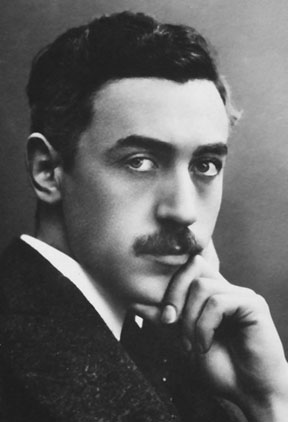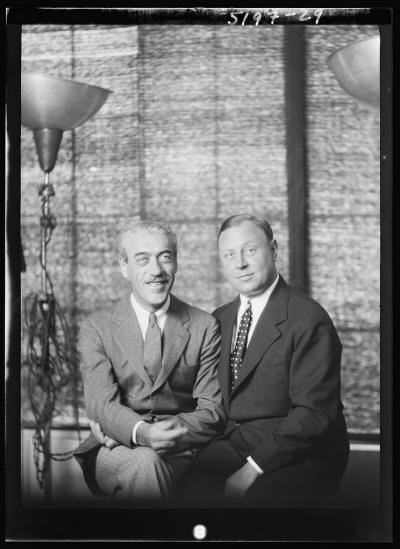

Queer Places:
Hotel Adlon, Unter den Linden 77, 10117 Berlin
Hotel Esplanade, Bellevuestraße 1, 10785
Norra Begravningsplatsen, 171 64 Solna, Sweden
 Mauritz
Stiller (born Moshe Stiller, 17 July 1883 – 18 November 1928) was a Swedish
film director of Finnish Jewish origin, best known for discovering
Greta Garbo and
bringing her to America. When, at the tail end of the silent era, Mauritz
Siller and F.W. Murnau were imported
to Hollywood, their homosexuality was a known commodity. Like the designer
Erté, they enjoyed as Europeans greater latitude in their personal freedom,
perhaps because their "foreignness" already set them apart.
Mauritz
Stiller (born Moshe Stiller, 17 July 1883 – 18 November 1928) was a Swedish
film director of Finnish Jewish origin, best known for discovering
Greta Garbo and
bringing her to America. When, at the tail end of the silent era, Mauritz
Siller and F.W. Murnau were imported
to Hollywood, their homosexuality was a known commodity. Like the designer
Erté, they enjoyed as Europeans greater latitude in their personal freedom,
perhaps because their "foreignness" already set them apart.
Rumors exist from the early 1930s that Nils Asther had relationships with Stiller. As a young man Nils Asther moved to Stockholm, where he received acting lessons from Augusta Lindberg. It was through Lindberg that Asther received his first theatrical engagement at Lorensbergsteatern in Gothenburg, and in 1916 Mauritz Stiller cast him in The Wings, a gay-themed Swedish silent film from 1916, directed by Stiller, based on Herman Bang's 1902 novel Mikaël.
Stiller had been a pioneer of the Swedish film industry, writing and directing many short films from 1912. When Metro-Goldwyn-Mayer invited him to Hollywood as a director, he arrived with his new discovery Greta Gustafsson, whose screen name Greta Garbo is believed to have been his suggestion.
After frequent disagreements with studio executives at MGM and Paramount Pictures, Stiller returned to Sweden, where he died soon afterwards.
Moshe Stiller was born in Helsingfors (now Helsinki). His family was of Ashkenazi Jewish heritage, having lived in Russia and Poland before settling in Finland, these countries being part of the Russian Empire. When he was four, his mother committed suicide, after which he was raised by family friends. From an early age, Stiller was interested in acting. His talents did not go unnoticed, and soon Stiller was offered the opportunity to practice and display his acting skills in the theaters of Helsingfors and Åbo in Finland.

Mauritz Stiller and Emil Jannings by Arnold Genthe
Drafted into the army of Czar Nicholas II — Finland was at the time an autonomous Grand Duchy of Finland, part of Russia — rather than report for duty he fled the country for exile, and settled in Sweden. He became a Swedish citizen in 1921.
By 1912, Stiller had become involved with Sweden's rapidly developing silent film industry. He began by writing scripts, acting and directing in short films but within a few years gave up acting to devote his time to writing and directing. He was soon directing feature-length productions, and his 1918 work Thomas Graals bästa barn (Thomas Graal's First Child), starring Karin Molander, and with Victor Sjöström in the leading role, received much acclaim.
By 1920, having directed more than 35 films, including Sir Arne's Treasure and Erotikon, Stiller was a leading figure in Swedish filmmaking. He also directed The Blizzard starring a young Einar Hanson and based on the Selma Lagerlof novel En herrgårdssägen.
At the Royal Dramatic Theatre in Stockholm, he met a young actress named Greta Gustafsson whom he cast in an important but secondary role in his film, Gösta Berlings saga (The Atonement of Gosta Berling), and who some have said gave her the stage name Greta Garbo. For Stiller, the screen presence of the 18-year-old actress led to him bringing her and Hanson to the United States after he accepted an offer from Louis B. Mayer to direct for Metro-Goldwyn-Mayer.
In Hollywood, Mauritz Stiller was assigned to direct The Temptress (1926), Garbo's second film with MGM, but he could not deal with the studio structure. After repeated arguments with MGM executives, he was replaced on the film by Fred Niblo, and his contract with the studio terminated. Stiller immediately was hired by Paramount Pictures, where he made three successful films, but he was let go a second time while directing his fourth film because of his continuing disagreements with studio bosses.
Mauritz Stiller returned to Sweden in 1927 and died the following year from pleurisy at the age of 45. He was interred in the Norra begravningsplatsen in Stockholm.
Stiller's contribution to the motion picture industry was recognized in 1960 with a star on the Hollywood Walk of Fame at 1713 Vine Street. Originally his star was listed erroneously as "Maurice Diller" and wasn't corrected until the late 1980s. In Kristianstad, a monument was erected in his honor.
My published books: